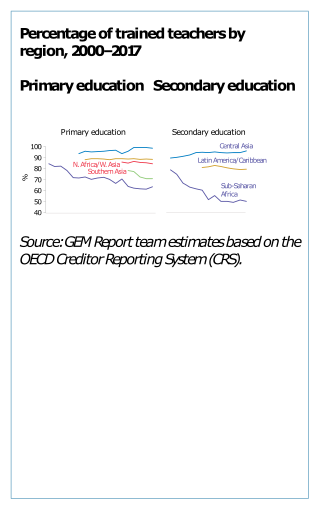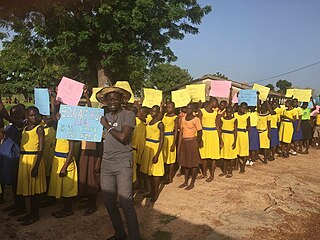Related Research Articles
Special education is the practice of educating students in a way that accommodates their individual differences, disabilities, and special needs. This involves the individually planned and systematically monitored arrangement of teaching procedures, adapted equipment and materials, and accessible settings. These interventions are designed to help individuals with special needs achieve a higher level of personal self-sufficiency and success in school and in their community, which may not be available if the student were only given access to a typical classroom education.
Blended learning or hybrid learning, also known as technology-mediated instruction, web-enhanced instruction, or mixed-mode instruction, is an approach to education that combines online educational materials and opportunities for interaction online with physical place-based classroom methods.
Cooperative learning is an educational approach which aims to organize classroom activities into academic and social learning experiences. There is much more to cooperative learning than merely arranging students into groups, and it has been described as "structuring positive interdependence." Students must work in groups to complete tasks collectively toward academic goals. Unlike individual learning, which can be competitive in nature, students learning cooperatively can capitalize on one another's resources and skills. Furthermore, the teacher's role changes from giving information to facilitating students' learning. Everyone succeeds when the group succeeds. Ross and Smyth (1995) describe successful cooperative learning tasks as intellectually demanding, creative, open-ended, and involve higher-order thinking tasks. Cooperative learning has also been linked to increased levels of student satisfaction.
Educational technology is the combined use of computer hardware, software, and educational theory and practice to facilitate learning. When referred to with its abbreviation, edtech, it often refers to the industry of companies that create educational technology.
In education, Response to Intervention is an approach to academic intervention used to provide early, systematic, and appropriately intensive assistance to children who are at risk for or already underperforming as compared to appropriate grade- or age-level standards. RTI seeks to promote academic success through universal screening, early intervention, frequent progress monitoring, and increasingly intensive research-based instruction or interventions for children who continue to have difficulty. RTI is a multileveled approach for aiding students that is adjusted and modified as needed if they are failing.

Teacher education or teacher training refers to programs, policies, procedures, and provision designed to equip (prospective) teachers with the knowledge, attitudes, behaviors, approaches, methodologies and skills they require to perform their tasks effectively in the classroom, school, and wider community. The professionals who engage in training the prospective teachers are called teacher educators.

Inclusion in education refers to all students being able to access and gain equal opportunities to education and learning. It arose in the context of special education with an individualized education program or 504 plan, and is built on the notion that it is more effective for students with special needs to have the said mixed experience for them to be more successful in social interactions leading to further success in life. The philosophy behind the implementation of the inclusion model does not prioritize, but still provides for the utilization of special classrooms and special schools for the education of students with disabilities. Inclusive education models are brought into force by educational administrators with the intention of moving away from seclusion models of special education to the fullest extent practical, the idea being that it is to the social benefit of general education students and special education students alike, with the more able students serving as peer models and those less able serving as motivation for general education students to learn empathy.
English-Language Learner is a term used in some English-speaking countries such as the United States and Canada to describe a person who is learning the English language and has a native language that is not English. Some educational advocates, especially in the United States, classify these students as non-native English speakers or emergent bilinguals. Various other terms are also used to refer to students who are not proficient in English, such as English as a Second Language (ESL), English as an Additional Language (EAL), limited English proficient (LEP), Culturally and Linguistically Diverse (CLD), non-native English speaker, bilingual students, heritage language, emergent bilingual, and language-minority students. The legal term that is used in federal legislation is 'limited English proficient'. The instruction and assessment of students, their cultural background, and the attitudes of classroom teachers towards ELLs have all been found to be factors in the achievement of these students. Several methods have been suggested to effectively teach ELLs, including integrating their home cultures into the classroom, involving them in language-appropriate content-area instruction early on, and integrating literature into their learning programs.
The Orton-Gillingham approach is a multisensory phonics technique for remedial reading instruction developed in the early-20th century. It is practiced as a direct, explicit, cognitive, cumulative, and multi-sensory approach. While it is most commonly associated with teaching individuals with dyslexia, it is highly effective for all individuals learning to read, spell, and write. In the US, it is promoted by more than 15 commercial programs as well as several private schools for students with dyslexia and related learning disabilities.

Tracking is separating students by academic ability into groups for all subjects or certain classes and curriculum within a school. It may be referred to as streaming or phasing in some schools.
Direct instruction (DI) is the explicit teaching of a skill-set using lectures or demonstrations of the material to students. A particular subset, denoted by capitalization as Direct Instruction, refers to the approach developed by Siegfried Engelmann and Wesley C. Becker that was first implemented in the 1960s. DI teaches by explicit instruction, in contrast to exploratory models such as inquiry-based learning. DI includes tutorials, participatory laboratory classes, discussion, recitation, seminars, workshops, observation, active learning, practicum, or internships. Model includes "I do" (instructor), "We do", "You do".

Learning disability, learning disorder, or learning difficulty is a condition in the brain that causes difficulties comprehending or processing information and can be caused by several different factors. Given the "difficulty learning in a typical manner", this does not exclude the ability to learn in a different manner. Therefore, some people can be more accurately described as having a "learning difference", thus avoiding any misconception of being disabled with a possible lack of an ability to learn and possible negative stereotyping. In the United Kingdom, the term "learning disability" generally refers to an intellectual disability, while conditions such as dyslexia and dyspraxia are usually referred to as "learning difficulties".

Virtual math manipulatives are visual representations of concrete math manipulatives. They are digitally accessed through a variety of websites or apps through tablets, phones and computers. Virtual math manipulatives are modeled after concrete math manipulatives that are commonly used in classrooms to concretely represent abstract mathematical concepts and support student understanding of mathematical content.
The term twice exceptional, often abbreviated as 2e, entered educators' lexicons in the mid-1990s and refers to gifted students who have some form of learning or developmental disability. These students are considered exceptional both because of their giftedness and because they are disabled or neurodiverse. Ronksley-Pavia (2015) presents a conceptual model of the co-occurrence of disability and giftedness.
A resource room is a separate, remedial classroom in a school where students with educational disabilities, such as specific learning disabilities, are given direct, specialized instruction and academic remediation and assistance with homework, and related assignments as individuals or in groups.
Peer instruction is an evidence-based, interactive teaching method popularized by Harvard Professor Eric Mazur in the early 1990s. Originally used in many schools, including introductory undergraduate physics classes at Harvard University, peer instruction is used in various disciplines and institutions around the globe. It is a student-centered approach that involves flipping the traditional classroom by moving information transfer out and moving information assimilation, or application of learning, into the classroom. There is some research that supports the effectiveness of peer instruction over more traditional teaching methods, such as traditional lecture.

A flipped classroom is an instructional strategy and a type of blended learning, which aims to increase student engagement and learning by having pupils complete readings at home and work on live problem-solving during class time. This pedagogical style moves activities, including those that may have traditionally been considered homework, into the classroom. With a flipped classroom, students watch online lectures, collaborate in online discussions, or carry out research at home, while actively engaging concepts in the classroom, with a mentor's guidance.
Lynn Fuchs is an educational psychologist known for research on instructional practice and assessment, reading disabilities, and mathematics disabilities. She is the Dunn Family Chair in Psychoeducational Assessment in the Department of Special Education at Vanderbilt University.
Inclusive Classroom is a term used within American pedagogy to describe a classroom in which all students, irrespective of their abilities or skills, are welcomed holistically. It is built on the notion that being in a non-segregated classroom will better prepare special-needs students for later life. In the United States, the Rehabilitation Act of 1973 guaranteed civil rights to disabled people, though inclusion of disabled students progressed slowly until the No Child Left Behind Act of 2001, after which almost half of US students with disabilities were soon in general classrooms.
Donna Y. Ford is an American educator, anti-racist, advocate, author and academic. She is a distinguished professor of education and human ecology and a faculty affiliate with the center for Latin American studies in the college of arts and sciences, and the Kirwan Institute in the college of education and human ecology at Ohio State University.
References
- ↑ Hartnett, Joanie; Weed, s strengths; McCoy, Ann; Theiss, Deb; Nickens, Nicole (2013). "Co-Teaching: A New Partnership During Student Teaching" (PDF). SRATE Journal. 23 (1): 1–12.
- ↑ Mofield, Emily L. (20 December 2019). "Benefits and Barriers to Collaboration and Co-Teaching: Examining Perspectives of Gifted Education Teachers and General Education Teachers". Gifted Child Today. 43 (1): 20–33. doi: 10.1177/1076217519880588 . S2CID 213104917.
- ↑ Cherian, Finney (1 January 2007). "Learning to Teach: Teacher Candidates Reflect on the Relational, Conceptual, and Contextual Influences of Responsive Mentorship". Canadian Journal of Education. 30 (1): 25–46. doi:10.2307/20466624. JSTOR 20466624.
- ↑ Friend, M.; Cook, L.; Hurley-Chamberlain, D.; Shamberger, C. (February 2010). "Co-teaching: An illustration of the complexity of collaboration in special education". Journal of Educational and Psychological Consultation. 20 (1): 9–27. doi:10.1080/10474410903535380. ISSN 1047-4412. S2CID 143670464.
- ↑ Simmons, R. J.; Magiera, K. (2007). "Evaluation of Co-Teaching in Three High Schools within One School District: How Do You Know when You Are TRULY Co-Teaching?". TEACHING Exceptional Children Plus. 3 (3): 1–12.
- ↑ Mofield, Emily L. (20 December 2019). "Benefits and Barriers to Collaboration and Co-Teaching: Examining Perspectives of Gifted Education Teachers and General Education Teachers". Gifted Child Today. 43 (1): 20–33. doi: 10.1177/1076217519880588 . S2CID 213104917.
- ↑ Cook, Lynne; Friend, Marilyn (November 1995). "Co-Teaching: Guidelines for Creating Effective Practices". Focus on Exceptional Children. 28 (3). doi:10.17161/foec.v28i3.6852. ISSN 0015-511X.
- ↑ "5 Co-Teaching Formats". Curry School of Education . University of Virginia. Archived from the original on 9 November 2014.
- ↑ Scruggs, Thomas E.; Mastropieri, Margo A.; McDuffie, Kimberly A. (July 2007). "Co-Teaching in Inclusive Classrooms: A Metasynthesis of Qualitative Research". Exceptional Children. 73 (4): 392–416. doi:10.1177/001440290707300401. ISSN 0014-4029. S2CID 2284080.
- ↑ Murawski, Wendy W. (September 2006). "Student Outcomes in Co-Taught Secondary English Classes: How Can We Improve?". Reading & Writing Quarterly. 22 (3): 227–247. doi:10.1080/10573560500455703. ISSN 1057-3569. S2CID 54845512.
- ↑ Chanmugam, Amy; Gerlach, Beth (2013). "A Co-Teaching Model for Developing Future Educators' Teaching Effectiveness" (PDF). International Journal of Teaching and Learning in Higher Education. 25 (1): 110–117. ISSN 1812-9129.
- ↑ Walther-Thomas, C. S. (1 July 1997). "Co-Teaching Experiences: The Benefits and Problems That Teachers and Principals Report Over Time". Journal of Learning Disabilities. 30 (4): 395–407. doi:10.1177/002221949703000406. PMID 9220708. S2CID 21134830.
- ↑ Vaughn, Sharon; Klingner, Janette K. (July 1998). "Students' Perceptions of Inclusion and Resource Room Settings". The Journal of Special Education. 32 (2): 79–88. doi:10.1177/002246699803200202. ISSN 0022-4669. S2CID 145528040.